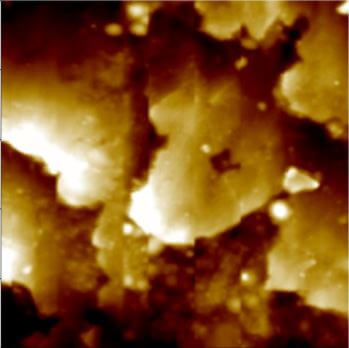
Products for sun protection such as hats, sunscreen, and clothing are commonly used to prevent skin irritation and damage, but few products for protecting hair exist. Through researching the radiation effects of sunlight on hair, it is to be determined whether or not this is a concern worth looking into, especially for those with less photostable, fair-colored hair. With the Park NX20 Atomic Force Microscope (AFM) and its user-friendly Park SmartScan software’s Auto mode, images of hair can be produced to compare its nanoscale topography before and after prolonged exposure to sunlight.
The post-exposure sample analysis will be focused on topographical changes indicative of structural damage, as well as a cross section view analysis to assess possible internal changes. Several 5 µm x 5 µm areas on the hair are examined to quantify damage in terms of change in surface roughness value (Rq). Both types of hair were observed to lose surface roughness after prolonged sunlight exposure with black hair decreasing in roughness 77.3% less than blonde hair did. This indicates that prolonged sunlight exposure smoothens hair by wearing out its surface layers evenly and that black hair is more resistant to this process than blonde hair is.
This observation is further supported our cross section data as black hair’s cuticle layer width decreased by 0.1 µm and whereas a cuticle layer decrease of 1.5 µm was observed in blonde hair.
This study’s objective is to observe the effects of long term exposure of sunlight on hair fiber. Many fear the damaging effects of prolonged sunlight exposure on skin, yet few stop to think about the implications of such damage on hair. Black hair is known to be more resistant to sunlight damage than blonde hair [1] due to black hair containing the photo-unstable pigment pheomelanin in levels only a fifth of what is found in blonde hair [2]. This key difference suggests that solutions to mitigate the damage of prolonged sunlight exposure on hair will need to vary based on the target population’s hair color. Using a Park NX20 AFM system, the damage done by sunlight radiation on black and blonde hair will be compared by means of comparing surface roughness values (given as Root Mean Square roughness, Rq) before and after receiving a standardized dose of extended sunlight exposure. Because blonde hair contains five times more pheomelanin (a substance known for its low photostability) than black hair, it is expected that more free radicals will be produced in blonde hair. These free radicals are chemically reactive particles created in the presence of radiation. They effectively destroy the hair cuticle by reacting with nearby stable molecules and eroding the hair’s natural structure [3]. Hair after prolonged exposure to sunlight is deduced to be rougher due to what is expected will be an uneven formation of craters and pockets caused by free radical wear.
Consequently, changes from this radiation should also be visible in the cross section as we expect that the cuticle layers will thin out.
